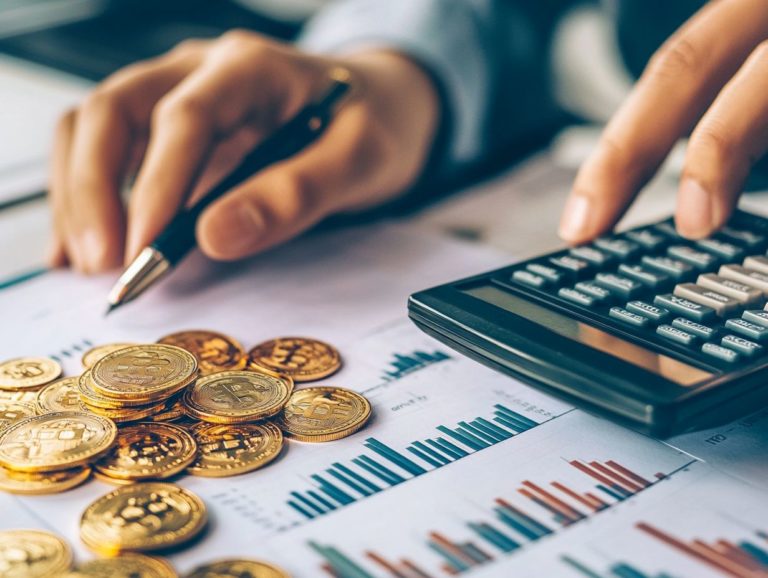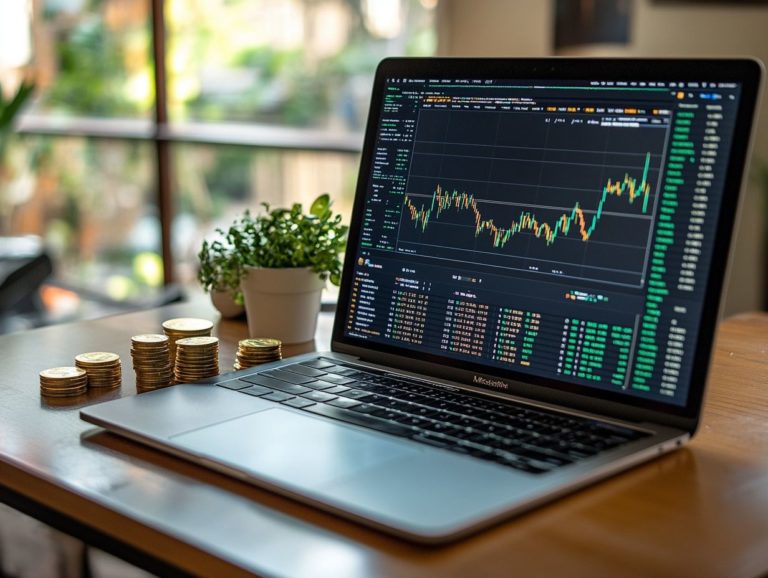What is the Role of Precious Metals in a Portfolio?
Precious metals have a timeless allure for investors, not only for their intrinsic beauty but also for enhancing financial security.
It s essential for you to understand the different types of precious metals, their historical performance, and how they stack up against other asset classes if you’re considering diversifying your portfolio.
This guide will delve into the benefits and risks associated with incorporating precious metals into your investment strategy, the factors that influence their value, and effective methods for managing investment risks.
Whether you re a seasoned investor or just beginning your journey, this resource will empower you with the knowledge to navigate the world of precious metals with confidence.
Contents
- Key Takeaways:
- Understanding Precious Metals
- Historical Performance of Precious Metals
- The Role of Precious Metals in a Diversified Portfolio
- Factors Affecting the Value of Precious Metals
- How to Invest in Precious Metals
- Managing Risks in Precious Metal Investments
- Frequently Asked Questions
- What is the role of precious metals in a portfolio?
- How do precious metals differ from other types of investments?
- What are some examples of precious metals?
- Why are precious metals considered a safe haven for investors?
- How can I invest in precious metals?
- What are some potential risks associated with investing in precious metals?
Key Takeaways:

- Consider adding precious metals to your portfolio for better protection against market volatility!
- Precious metals, such as gold and silver, are physical assets with long-term value and historical stability.
- Investing in these metals can be an exciting opportunity, but it’s important to manage risks through diversification and hedging techniques.
Understanding Precious Metals
Understanding precious metals is essential in today’s economic landscape. These rare commodities have historically acted as a store of value, offering substantial economic benefits while serving as protection against rising prices.
Gold, silver, platinum, and palladium not only play pivotal roles in financial markets but also influence industrial processes. They are in high demand for various applications, including jewelry and electronics.
Their unique properties elevate them to the status of important financial assets, especially during periods of market uncertainty and geopolitical turmoil.
Definition and Types of Precious Metals
Precious metals are rare, naturally occurring metallic elements that hold significant economic value. When you think of precious metals, gold, silver, platinum, and palladium immediately come to mind, but there are also lesser-known players like rhodium, iridium, and osmium.
These metals are not merely admired for their beauty in jewelry; their unique properties make them important in many industries. For example, gold s exceptional conductivity and resistance to corrosion make it a favorite in electronics and aerospace technologies. Silver shines in its own right, boasting superior thermal and electrical conductivity, which makes it perfect for batteries and solar panels.
Then there s platinum and palladium, essential components in catalytic converters that help reduce harmful emissions from vehicles. During times of economic uncertainty, savvy investors often turn to real metal bars or coins as a safe haven, highlighting the timeless demand for these precious metals as a reliable hedge against inflation and currency fluctuations.
Historical Performance of Precious Metals
The historical performance of precious metals shows their strength and lasting value, particularly during periods of economic uncertainty. You ll notice that investment demand tends to surge in response to extreme events, such as financial crises and geopolitical tensions.
This consistent trend shows the appeal of precious metals as a reliable asset in turbulent times.
Comparison to Other Asset Classes
When you compare precious metals to other asset classes, they really tend to shine due to their unique investment characteristics. They also have a low correlation with traditional financial assets and can serve as attractive alternatives during various market cycles.
This distinctiveness makes them particularly appealing if you’re looking to diversify your portfolio. Unlike stocks and bonds, which often respond similarly to market fluctuations, precious metals usually retain their intrinsic value, especially during economic downturns. Furthermore, you might want to consider the role of precious metals in a tax-efficient portfolio for added financial benefits.
While stocks can promise high returns, they come with heightened risk; similarly, bonds are vulnerable to shifts in interest rates. Real estate might offer stability and income, but it s also subject to market volatility and liquidity constraints.
By incorporating precious metals into your investment strategy, you can mitigate overall risk and create a buffer against inflation and currency devaluation, helping you strike a more balanced approach.
The Role of Precious Metals in a Diversified Portfolio
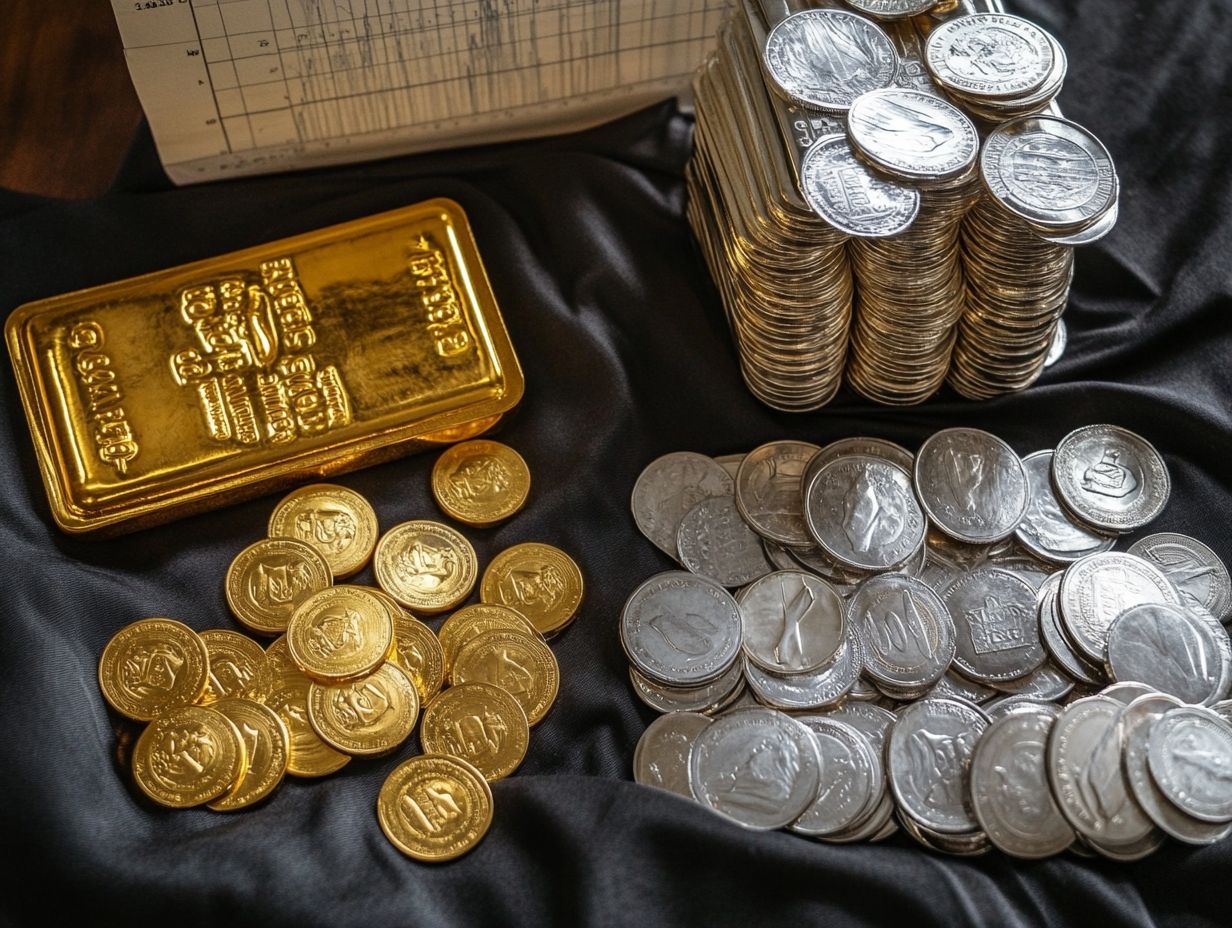
You increasingly recognize the significance of precious metals in a diversified portfolio. Their ability to enhance financial stability and deliver substantial benefits cannot be overstated. This is especially true during periods of economic uncertainty and market fluctuations.
Benefits and Risks of Including Precious Metals
Including precious metals in your investment strategy can offer a range of benefits. They can act as a hedge against overall financial issues and market fluctuations.
However, it s important to recognize that this approach also comes with unique risks that require careful consideration. Diversifying your portfolio with assets like gold and silver can protect your wealth from the negative effects of inflation, which can gradually diminish your purchasing power.
These tangible assets often maintain their value or even appreciate during uncertain economic times. This makes them an attractive option for those who prefer to minimize risk.
Remember, while precious metals can provide a sense of stability, they also come with liquidity risks, meaning the risk of not being able to sell quickly. Selling these assets can occasionally be challenging without incurring losses, especially in volatile markets.
Having a balanced understanding of both the potential rewards and the pitfalls is crucial for anyone considering this investment path.
Factors Affecting the Value of Precious Metals
A multitude of factors influences the value of precious metals. You must consider economic influences, investment demand, and the fluctuations in supply that can arise from geopolitical upheavals and the actions of market participants.
Each of these elements plays a critical role in shaping the landscape of precious metals valuation.
Economic and Market Influences
Economic and market influences are essential in shaping the value of precious metals. They respond to both pro-cyclical and counter-cyclical sources of demand amid systemic concerns and market uncertainty.
Consider the impact of interest rates on investor sentiment. When rates drop, you typically see an uptick in demand for gold and silver as attractive alternative investments. On the flip side, rising inflation can chip away at purchasing power, driving traders toward these tangible assets as a safeguard against devaluation.
Navigating this complex landscape means understanding how these economic indicators interact. This understanding empowers you to make well-informed decisions.
By cultivating a keen awareness of the dynamics at play, you’ll not only enhance your ability to predict price movements but also refine your strategic trading approaches amid the volatility that often defines the precious metals market.
How to Invest in Precious Metals
Investing in precious metals presents a range of methods. This includes acquiring physical bullion and exploring commodity ETFs and precious metals ETFs. Each avenue offers its own unique investment strategy, catering to your specific risk appetite and financial goals.
Methods and Strategies for Investing
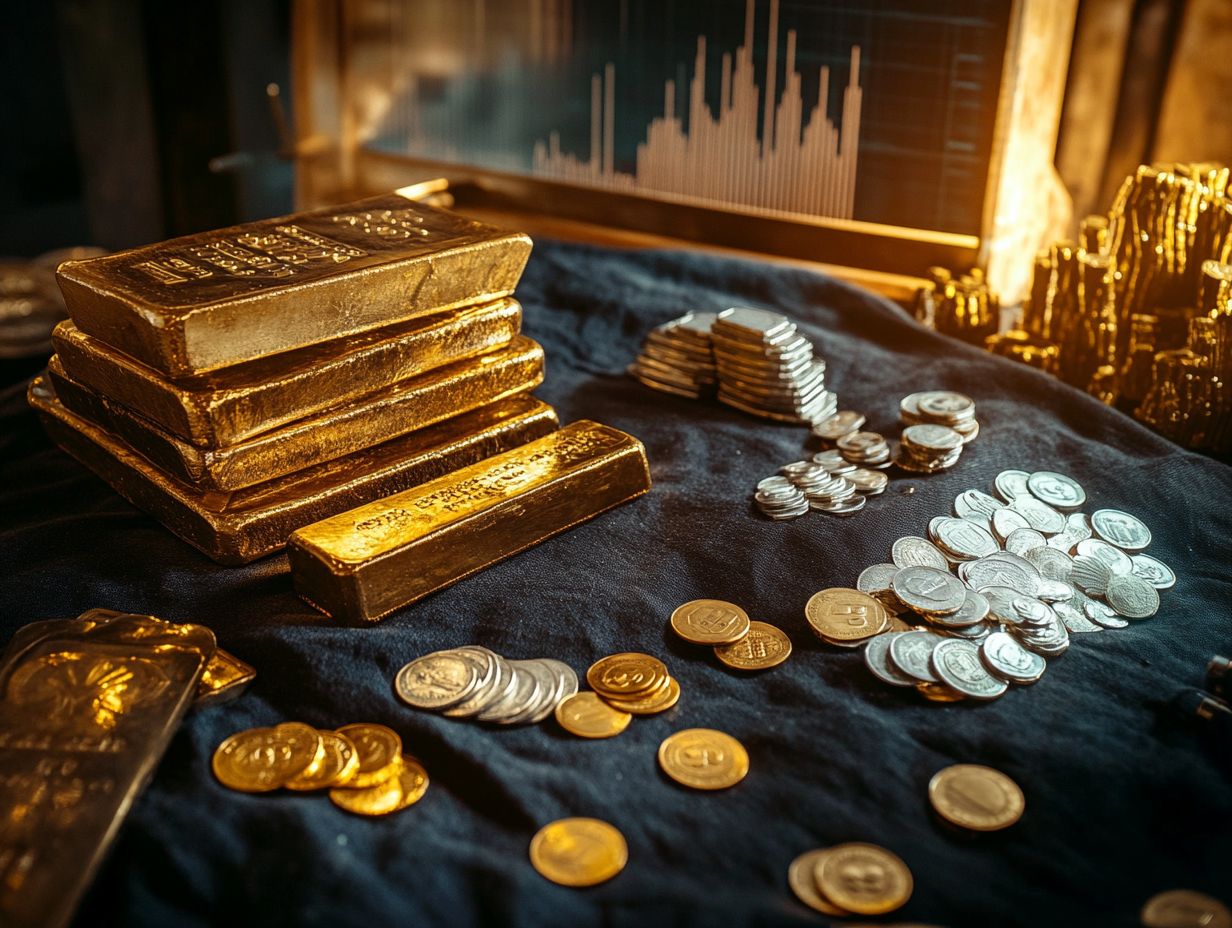
Different methods and strategies for investing in precious metals are designed to meet your unique investment demands and preferences. Whether you choose a physical commodity or lean towards more liquid trading mechanisms like ETFs, there are options available for you.
Futures contracts present another opportunity if you’re looking to hedge against market fluctuations or amplify your investments. However, it’s essential to be aware that they come with their own liquidity risks that require careful navigation.
Each investment option boasts distinct characteristics, such as how easily it can be converted into cash or the considerations of storage and security for physical assets. By understanding how these methods align with broader asset allocation strategies, you can customize your approach to achieve your individual financial goals while effectively mitigating the potential risks associated with each option.
Start exploring your options today to secure your financial future!
Managing Risks in Precious Metal Investments
Managing risks in precious metal investments is crucial for safeguarding your portfolio. You can achieve this by employing effective diversification and hedging strategies. These strategies enable you to navigate economic uncertainties with greater confidence.
Diversification and Hedging Strategies
Diversifying your portfolio with precious metals offers substantial benefits, especially during economic uncertainty and systemic concerns (widespread issues in the economy). Incorporating these assets helps mitigate liquidity risks while enhancing your overall investment profile.
Investors often choose gold and silver to buffer against market volatility. These precious metals typically have low correlation with stocks, allowing them to serve as safe havens when stock prices decline. Understanding what is the role of central banks in precious metals can further enhance your strategy. Including them in your diversified portfolio not only shields against inflation but also hedges against currency fluctuations that could impact your investment returns.
While the appeal of precious metals is undeniable, challenges such as storage costs and fluctuating prices may arise. As a savvy investor, you need to find the right balance in your strategies to maximize benefits.
Frequently Asked Questions
Got questions about investing in precious metals? Check out these frequently asked questions!
What is the role of precious metals in a portfolio?
Precious metals serve as a hedge against inflation and market volatility, providing stability and diversification to a portfolio.
How do precious metals differ from other types of investments?
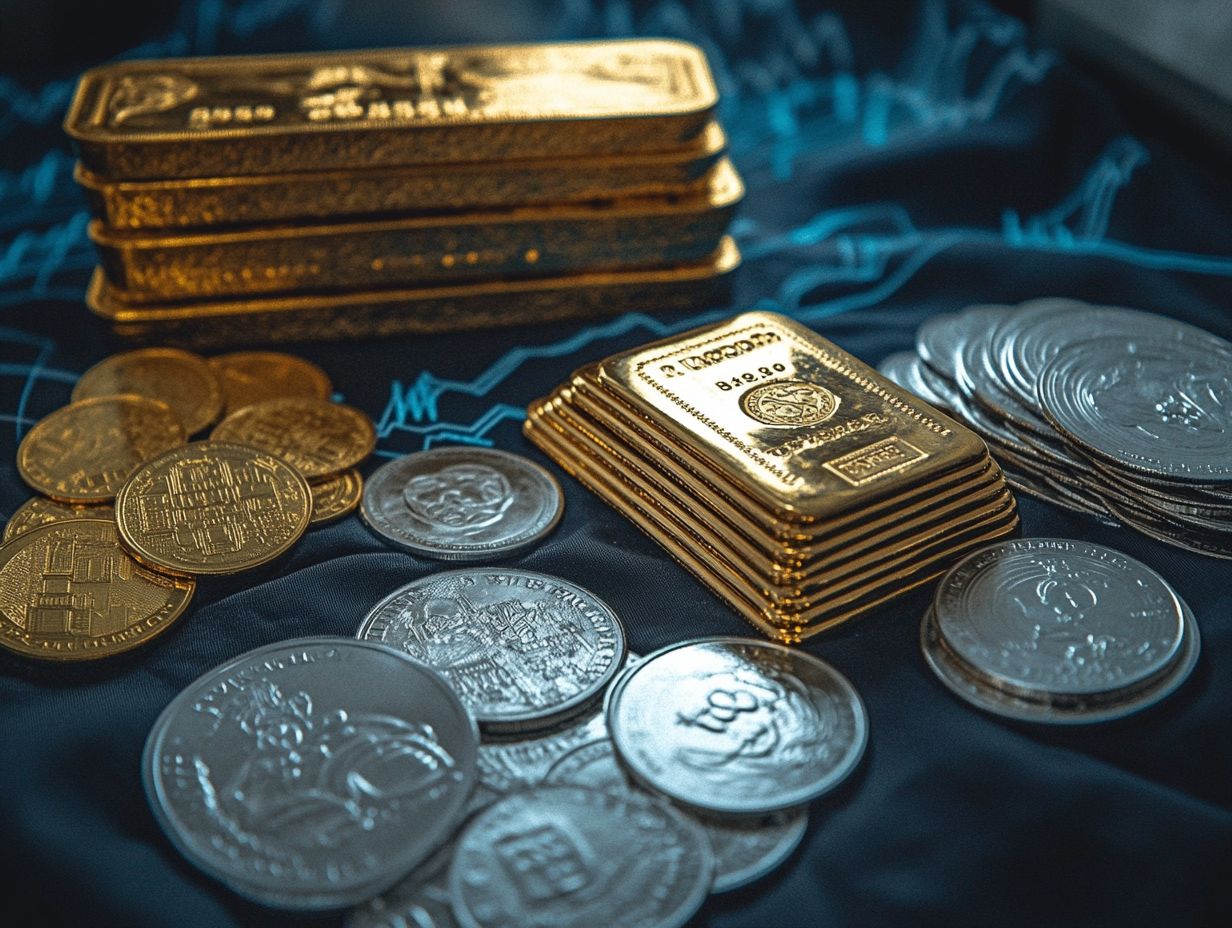
Precious metals are tangible assets that hold intrinsic value, unlike stocks or bonds which are based on company performance or interest rates.
What are some examples of precious metals?
Gold, silver, platinum, and palladium are all considered precious metals and can be used in investment portfolios.
Why are precious metals considered a safe haven for investors?
In times of economic uncertainty, investors tend to flock to precious metals as a safe and reliable store of value.
How can I invest in precious metals?
There are various ways to invest in precious metals, such as buying physical bullion, investing in mining stocks, or purchasing exchange-traded funds (ETFs) that track the price of these metals.
What are some potential risks associated with investing in precious metals?
Like any investment, there are risks involved with investing in precious metals, such as price volatility and the potential for fraud or counterfeit products. It is important to do thorough research and consult with a financial advisor before making any investment decisions.
Invest wisely now to protect your portfolio against the unexpected!











